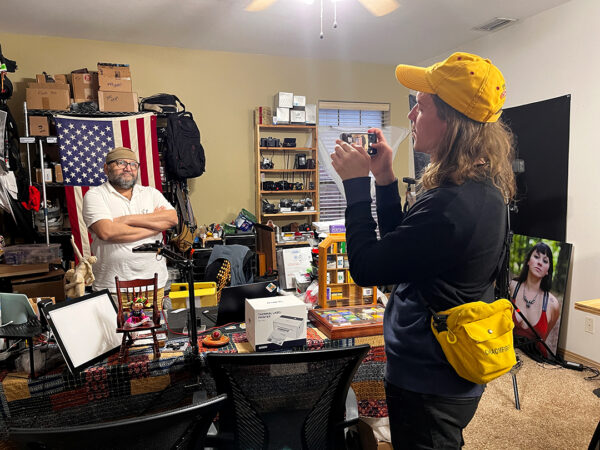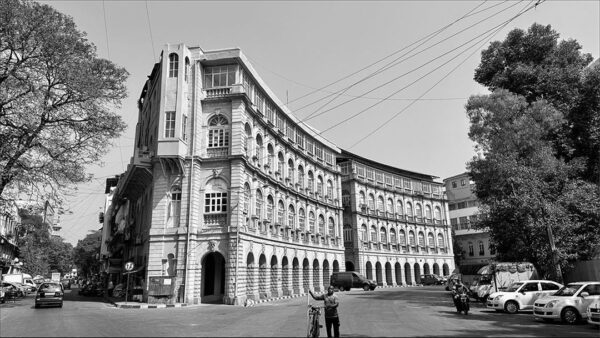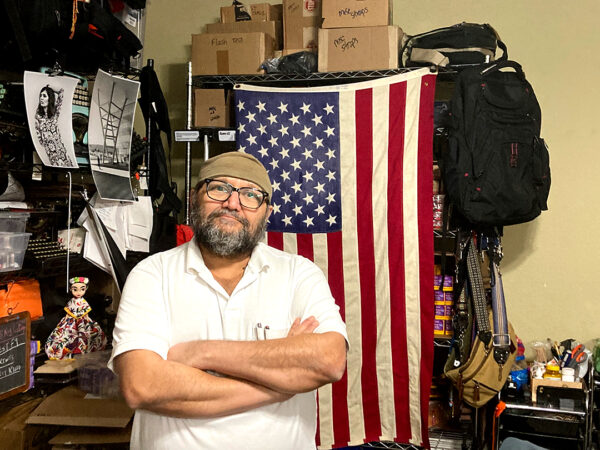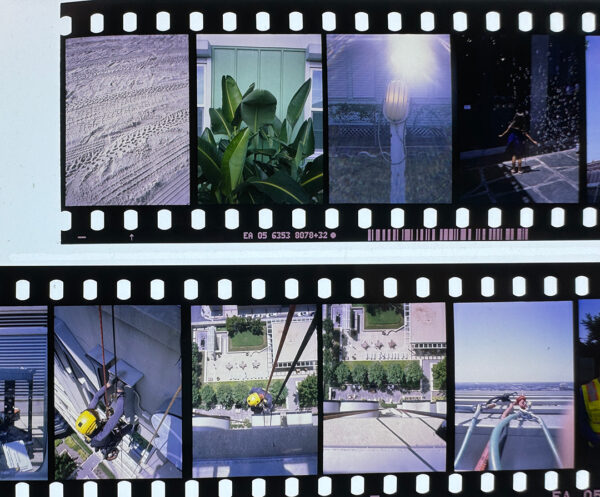Through my work at Glasstire, I have the opportunity to travel to Texas cities to see art and meet artists and cultural workers. As a photographer, I always bring a camera or two to document the varied places I encounter on these journeys. So of course, when I happen upon a camera store in a small Texas town, I am compelled to pop in and see what’s available. Since the closure of the Marfa Film Shop last November, I’ve lamented not taking a moment to share some of the people and places that make film photography accessible throughout the state.
In January 2023, I made my first trip down to the Rio Grande Valley. With several cameras in tow, I realized just a few days into the trip that I did not pack enough film. Driving from Laredo to McAllen, I was unsure if I would be able to remedy the situation, but a quick Google Maps search brought up Art By Pino. Navigating over to the location, I was surprised to arrive at an apartment complex. At the time, Pino Shah was selling film, cameras, and darkroom equipment, as well as processing and scanning negatives out of his apartment. Since November 2023, he no longer takes in-person visits, and now conducts all of his business online. At the time, being able to go by and pick up a few rolls of film was a lifesaver; it’s still good to know that his shop remains active, even if the trip requires a little more planning.
Recently, I checked in with Shah to learn more about the roots of his business and how things have shifted over the last year since we met.
Jessica Fuentes (JF): Before we dive into your shop, Art By Pino, tell me a little bit about when and why you got into photography.
Pino Shah (PS): I was nine years old, and I had a school picnic. My brother-in-law loaned me a tiny camera, a 120 camera, and showed me how to load the film under the blanket, because supposedly you’re supposed to do it in a dark space. And then I went and took pictures of the picnic, got them developed, and to my and my family’s surprise, the pictures came out great — composition, everything, every which way. First, it was like, okay, this was a fluke, whatever. I shot another roll, and, again, the same blessing followed. So from there on I was designated the family photographer, a de facto family photographer, and started shooting all of our events, everything, from then on. But again, this was back in… we’re talking about 1977 or 1978… there’s no digital at that time.
And then life happened, and I came to the U.S. to do my MBA at [The University of Texas Rio Grande Valley]; it used to be known as PAN AM [The University of Texas-Pan American], but photography wasn’t really on top of my agenda until 1995 or 1996 when digital cameras came out.
My first cousin, who lives in India, was visiting here and one day she just asked, “Can I see your pictures?” And I go, “What do you mean, see my pictures?” And she goes, “Pictures. You’ve been taking them all these years?” (Because I came to the US in 1987.) And I said, “You know, I stopped taking pictures.” And she was like, “What? How could you stop taking pictures?” So long story short, thanks to her persuasion, I got back into photography. I bought my first Sony digital camera that came out, which was quite expensive back then. Then I started shooting digital, until COVID happened.
JF: When did you first open your shop and what was the early iteration of it like? How did it change over the years?
PS: Let me see… it opened in October 2019 [and at the time] I started dealing in fountain pens and typewriters. Then the next logical thing that goes with typewriters and fountain pens is pocket watches — you know, manual, impact pocket watches. And next thing that goes with this is analog photography, vinyl, the whole analog world kind of thing. So, I got back into it. Pretty soon I realized, oh, this is getting expensive, as much as I’m shooting. It’s better for me to learn how to do my own developing.
I contacted a local professor who used to teach at the university for the film photography program, because I didn’t know how to develop… she said… that if I wanted to [learn I should] actually take the class… Well, the class is a whole semester… and I didn’t have that kind of time. So, what do you do next? You go to YouTube or you do Facebook groups. And in about three months, after screwing up a few rolls, I learned how to do black and white [film processing]. And then once I was comfortable, I started offering [film development] in the community here locally.
JF: When I met you, I was driving through town and was able to just come by, but I noticed on your website that you don’t do in-person sales anymore. Is there a reason why you switched away from that? What has been productive about switching to this new model?
PS: My business has grown at least three- if not five-fold since I stopped doing in-person visits. Because people say they’ll show up and they don’t show up… it was a huge, huge mess. Now, if I had a brick and mortar store, which I intentionally decided not to have, it would be different because I’d probably have staffing and it wouldn’t be a big deal. But I was running so tight in my appointments, and then the e-commerce portion of my business grew quite rapidly. And that’s a lot of packaging and shipping, and shipments coming in, and shipments going out. It just disrupted everything.
I still have some old, reliable, faithful customers that I will receive, but for the most part, I also realized that anywhere in the Valley, things will get shipped within one to two days… and so it just makes sense to do that. And I travel a lot now… I just got back from a three week trip from India. I’m here for a week, then I’m gone for 12 days to Mexico. Then I’m back for two weeks, and then I’m gone on a much longer, almost 20-day trip through all of Northern Mexico.
JF: Tell me more about working with clients in Mexico and what that has been like.
PS: I have some big buyers in Mexico City, in addition to Monterrey, Oaxaca, Mérida (which is in the Yucatán), Guadalajara, Veracruz, Querétaro, Puerto Vallarta… There’s a map I posted on Instagram, so teal is where I currently have presence, and purple is where I am visiting this year to see if I can have a presence there.
[I’ll] meet up with film shop owners, even photography shop owners (not necessarily exclusive film shops), and they are mostly younger generations. In some cases, it’s a family business, like the third-generation is running it. They were already in the film business, digital came, and they transitioned away from film. Now film is coming back, and they need someone who can supply it to them at a reasonable cost and on a steady basis. That’s the niche that I’ve been able to fulfill in Mexico, and in Mexico doing business is very much like India: until you show up in person and shake their hand, they’ll hesitate doing business with you. That’s why I travel so much to Mexico.
JF: Overall, what kinds of products do you think have been most popular lately?
PS: Well, with film, it’s always been the black and white films for the beginners that I recommend, though usually they want Portra 400 or 800. I’m like, “Look, I’ll sell you whatever you want, but may I suggest…” and I usually will try to tell them to try out a 400 film or Arista, which is the brand specifically that most photography classes use across the United States. That’s what sells the most for me. And now, the one in bulk sells because people are also learning how to do their own bulk loading, because that brings the cost down to like $2 or $2.50 a roll.
Of course, the color films Fuji 200, Fuji 400 [are popular too] — (for people that don’t know, it’s the same film as Kodak Gold 200 and Ultra Max 400, because Kodak makes the film). There’s only one company in the world that makes the majority of the color films — it’s Kodak. There are companies like ORWO, and like Harmon Photo, which recently introduced their first color film, and there’s another one coming out… But 99.9% of the production is done by Kodak. So, Kodak Gold, Kodak UltraMax, Fuji 200, Fuji 400, Portra 400, Portra 800… these are your classic, staple films. The more discerning users want the slide films, but it gets expensive.
The other thing that’s popular in retail is the half-frame camera.
JF: Yeah, I picked one of those up last year.
PS: Normally, I would have never even contemplated shooting half-frame, but I was amazed by [the Kodak Ektar H35N]. It has one element that is glass, the other one is plastic, and both of them are coated. I was stunned by the results that this thing produced. So now I carry one on me all the time, loaded with the most expensive film because hey, I’m still getting two shots [per frame]. You get 72 pictures on it, [it’s a] great value. So, just on that note, I don’t think film is going anywhere.
Check out Pino Shah’s online shop at artbypino.com and stay up to date with his company via social media.







